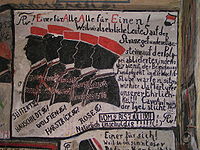
Karzer
Encyclopedia


Germany
Germany , officially the Federal Republic of Germany , is a federal parliamentary republic in Europe. The country consists of 16 states while the capital and largest city is Berlin. Germany covers an area of 357,021 km2 and has a largely temperate seasonal climate...
. Karzers existed both at universities and at gymnasiums
Gymnasium (school)
A gymnasium is a type of school providing secondary education in some parts of Europe, comparable to English grammar schools or sixth form colleges and U.S. college preparatory high schools. The word γυμνάσιον was used in Ancient Greece, meaning a locality for both physical and intellectual...
(similar to a grammar school) in Germany until the beginning of the twentieth century. Marburg
Marburg
Marburg is a city in the state of Hesse, Germany, on the River Lahn. It is the main town of the Marburg-Biedenkopf district and its population, as of March 2010, was 79,911.- Founding and early history :...
's last Karzer inmate, for example, was registered as late as 1931. Karzer punishment was formally abolished by Nazi university regulations.
Responsible for the administration of the Karzer was the so-called Pedell
Bedel
The bedel was, and is to some extent still, an administrative official at universities in several European countries, and often had a policiary function at the time when universities had their own jurisdiction over...
(English: bedel
Bedel
The bedel was, and is to some extent still, an administrative official at universities in several European countries, and often had a policiary function at the time when universities had their own jurisdiction over...
), or during later times Karzerwärter (a warden
Warden (college)
A warden is the head of some colleges and other educational institutions. This applies especially at some colleges and institutions at the University of Oxford:* All Souls College* Greyfriars* Keble College* Merton College* New College* Nuffield College...
). While Karzer arrest originally would have been a severe punishment, the respect for these punishment diminished with time, particularly in the 19th century, as it came a matter of honour to have been incarcerated at least once during one's time at university. At the end of 19th century, as the students in the cell became responsible for their own food and drink and receiving of visitors became permitted, the "punishment" would often turn into a social occasion with excessive consumption of alcohol.
Karzers have been preserved at the universities of Heidelberg, Jena, Marburg, Freiburg, Tübingen, Freiberg (School of Mines), Greifswald, Göttingen and at Friedrich-Alexander-Universität Erlangen-Nürnberg
Friedrich-Alexander-University, Erlangen-Nuremberg
The Universität Erlangen Nürnberg is a university in the cities of Erlangen and Nuremberg in Bavaria, Germany. It is the second largest state university in Bavaria, having five Schools, 308 chairs, and 12,000 employees. There are 28,735 students enrolled at the university, of which about 2/3 are...
in Erlangen
Erlangen
Erlangen is a Middle Franconian city in Bavaria, Germany. It is located at the confluence of the river Regnitz and its large tributary, the Untere Schwabach.Erlangen has more than 100,000 inhabitants....
. The Karzer in Göttingen
Göttingen
Göttingen is a university town in Lower Saxony, Germany. It is the capital of the district of Göttingen. The Leine river runs through the town. In 2006 the population was 129,686.-General information:...
was known, after the Pedell
Bedel
The bedel was, and is to some extent still, an administrative official at universities in several European countries, and often had a policiary function at the time when universities had their own jurisdiction over...
Brühbach, as Hotel de Brühbach; it was moved in the 19th century, because of the extension of the university library, to the Aula building; a cell door, preserved from the old Karzer, shows graffiti
Graffiti
Graffiti is the name for images or lettering scratched, scrawled, painted or marked in any manner on property....
by Otto von Bismarck
Otto von Bismarck
Otto Eduard Leopold, Prince of Bismarck, Duke of Lauenburg , simply known as Otto von Bismarck, was a Prussian-German statesman whose actions unified Germany, made it a major player in world affairs, and created a balance of power that kept Europe at peace after 1871.As Minister President of...
. Bearing witness to how the students spent the time in the cell are the many memorable wall, table and door paintings left by students in the cells and today shown as tourist attractions in the older German universities.
Literature
- Mark TwainMark TwainSamuel Langhorne Clemens , better known by his pen name Mark Twain, was an American author and humorist...
, A Tramp AbroadA Tramp AbroadA Tramp Abroad is a work of non-fiction travel literature by American author Mark Twain, published in 1880. The book details a journey by the author, with his friend Harris , through central and southern Europe...
. (With reference to the Karzer at Heidelberg University). - Mooney, Carolyn J.: Notes from Academe: Germany. Slammer or Shrine? How German Students Left Their Mark on the Walls of a Campus Prison. In: The Chronicle of Higher Education, March 1, 1996, A 55. [Göttingen].
External links
- The Karzer of Friedrich-Alexander-Universität Erlangen-Nürnberg
- German Text: History of TU Freiberg
- The Karzer of the University of Göttingen
- The Karzer of Ernst-Moritz-Arndt- Universität Greifswald
- The Karzer of the University of Heidelberg
- The former Karzer of the University of Leipzig
- The Karzer of Philipps-Universität Marburg
- German Text: The Karzer of Albert-Ludwigs-Universität Freiburg
- The Karzer of the University of Tübingen
- The Karzer of the 'Evangelisches Stift' Tübingen
- The Karzer of the University of Tartu (Estonia)
- The Karzer of the Latvian University in Riga (former Polytechnicum) - The final two lock-ups had been established in the manner and tradition of German campus prisons.

